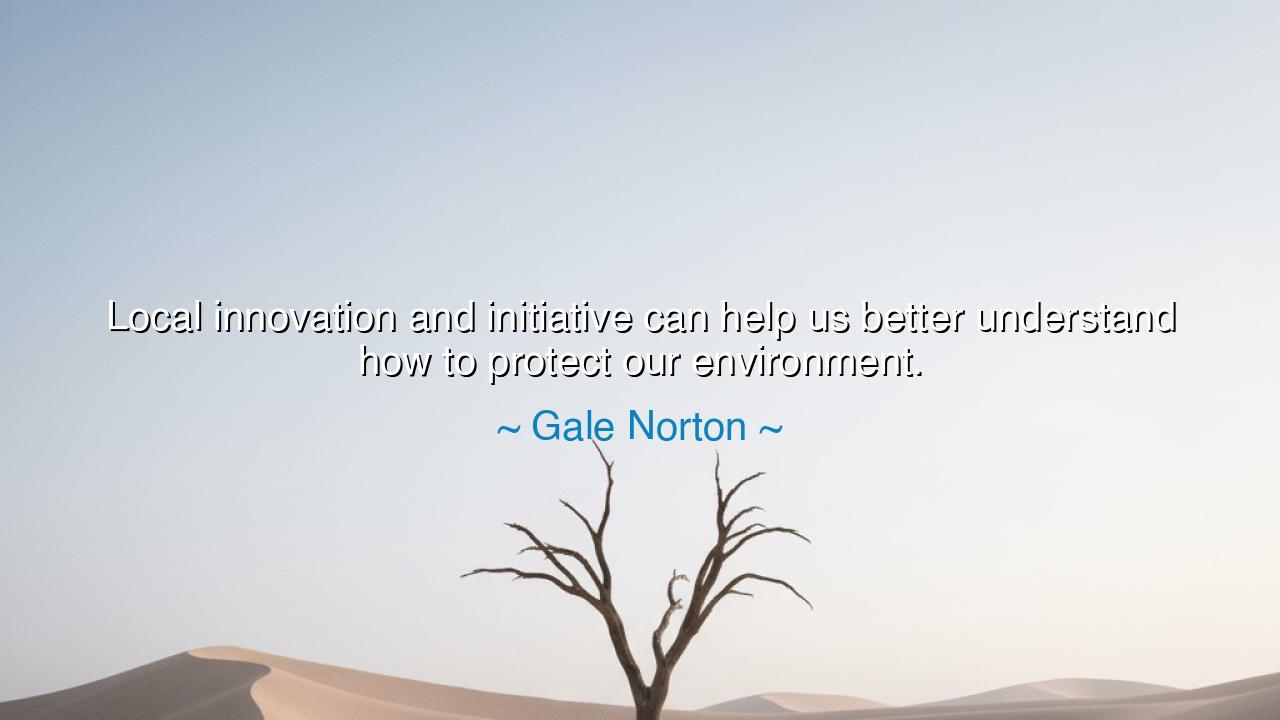
Local innovation and initiative can help us better understand how
Local innovation and initiative can help us better understand how to protect our environment.






In the cadence of a village bell at dawn, Gale Norton offers a spare but sturdy oracle: “Local innovation and initiative can help us better understand how to protect our environment.” Hear the wisdom folded inside these few words. She does not summon distant saviors or abstract plans; she points to the hands already on the plow, the minds already reading the river, the neighbors who know which wind carries rain and which carries dust. The world is not only healed in grand assemblies; it is mended in kitchens, workshops, fields, and town halls where people stitch solutions that fit the grain of their place.
To praise local innovation is to honor the knowledge that grows from living close to consequence. The ancients taught that the well-keeper understands water better than the courtier who drinks it from crystal. So, too, the farmer who watches soil run from a bare slope invents the contour hedge; the fisher who sees the catch shrink proposes a seasonal rest; the schoolchild who walks past litter designs the route and ritual that keep the street clean. Such initiative is not a lesser science; it is science with a doorstep—hypothesis, trial, correction—carried out under weather and witness.
Consider a lamp from history. In New York’s Catskills, when the city’s water grew cloudy and costly to treat, the remedy did not begin with a larger filter far away, but with local stewards upstream: farmers fencing streams, restoring wetlands, replanting riparian shade, tuning manure management to the pulse of rain. The metropolis invested in the countryside; the countryside invested in its own best practices. The river cleared its voice. This was environmental protection by covenant rather than conquest—an elegant proof that the cheapest filter is a living landscape tended by those who dwell within it.
Lift another lamp from the hills of Nepal, where communities took up the care of their forests under community forestry compacts. Villagers marked boundaries, set harvest rules, replanted, and shared firewood and fodder by agreed measure. The result was not merely greener slopes; it was greener livelihoods—springs revived, soils steadied, time reclaimed from the long walk for fuel. Here, initiative became policy’s teacher: ministries learned from villages which rules held and which frayed, and the forest returned because the people were trusted to be its first guardians.
The meaning of Norton’s oracle, then, is not parochial pride but proper scale. Problems wear the shape of their places; therefore remedies should, too. A wetland city needs reedbeds and tide-room; a prairie town needs shelterbelts and soil armor; a mountain hamlet needs trail-ledgers and spring protection. Local innovation lets us test swiftly, fail cheaply, and learn honestly, while national and international frameworks can later lift and link what works. In this way, the wisdom of one valley becomes a lantern for the next.
What, then, is the lesson to carry like a talisman? Do not wait for permission to begin the small, right work that reveals the large, right path. Map your watershed and your waste; measure what you treasure; keep records as faithfully as you keep festivals. Convene your neighbors: the initiative that endures is the initiative that is shared. Invite elders who remember the river before the road, youth who will inherit the results, and artisans who can turn plans into posts, swales, and solar mounts. Let your town become a modest laboratory whose results are written not only in reports but in cleaner air, cooler streets, and birds returning to hedgerows.
And here are practices as plain as bread: plant native shade along hot corridors; capture roof water for gardens; build community compost that returns soil to soul; audit school energy and let students lead the fixes; create citizen science brigades that test streams and publish the truth; form buyer co-ops that favor producers who heal the land. Each act is a sentence in a longer poem, and the poem is called protecting our environment. Start where your feet stand; prove what your place can do; then teach it forward. For when local innovation lights many small fires, the night of neglect recedes—not by edict, but by example, not by thunder, but by a thousand steady hands.






AAdministratorAdministrator
Welcome, honored guests. Please leave a comment, we will respond soon